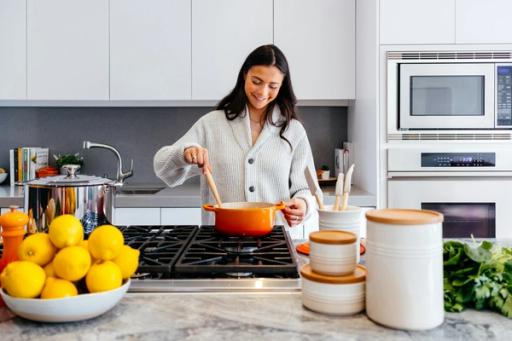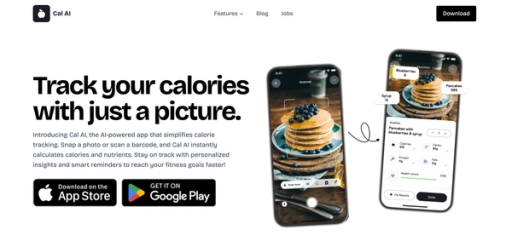
To stay on track with health goals, you need to know the calories in food. This is because, as you lose weight, your calorie needs change. So, To avoid hitting a plateau and keep progressing toward your goals, it’s best to measure calories in food at home as precisely as possible. This blog will give you valuable insights on accurately measuring calories in foods at home to help you maintain precise portion control, avoid overeating, and stay on track with your health goals. But, how calories are measured?
Cal AI’s Calorie Tracker is a valuable tool for achieving your objectives. Using this tool, you can quickly and accurately measure calories in food at home to maintain precise portion control, avoid overeating, and stay on track with health goals.

Measuring calories at home helps a person better understand how food affects their metabolism. Everyone processes food differently based on various factors, including:
Understanding the caloric content of foods can help you make better choices that support your goals, whether losing, gaining, or maintaining weight. Tracking calories can also help people identify foods that trigger unwanted reactions in their bodies, such as inflammation or digestive distress.
For example, if someone is experiencing gut issues, measuring calories may help them discover that a particular food has a lot of calories and they’re eating it in excess. Further investigation may reveal that specific food, such as a grain, is contributing to their gut distress. Measuring calories can help uncover that connection.
Calories are units of energy, and they come from the macronutrients in food:
Each macronutrient provides a specific amount of calories.
This means that you can determine the calorie content of your food by calculating the grams of each macronutrient.
One of the simplest ways to measure calories is by reading food labels on packaged products.
Here’s how:
For more accuracy, using a digital kitchen scale is ideal.
Here’s how to use it:
For instance, if you weigh 150 grams of chicken breast and 100 grams of chicken provides 165 calories, you can easily calculate the calories by multiplying:
(150 ÷ 100) × 165 = 247.5 calories
Many apps are designed to make calorie tracking convenient. These apps usually have large food databases, making it easy to find the exact calorie content of various foods.
Here’s how to use them:
These apps can even track your daily intake and give you insights into your nutrition like:
If you prefer to avoid apps, you can manually calculate calories using food composition tables, which provide the caloric values of various foods.
To do this:
For example, if you know that 100 grams of rice contains 130 calories, and you have 200 grams of cooked rice, the calculation is (200 ÷ 100) × 130 = 260 calories.
Tracking calories for homemade meals requires breaking down the recipe into its components.
Here’s how:
For example, if a homemade lasagna has 1,200 calories and is cut into four portions, each serving has 300 calories.
Figuring out the calories in the dishes you prepare is like solving a simple math problem. While it may sound obvious, adding the calories of each ingredient will give you the total calories in the final dish. To help you do this, Tufts University suggests using a computerized spreadsheet.
The United States Department of Agriculture has compiled a comprehensive nutrition label calculator that is free to use and contains many commonly found items for cooking or baking. If you cannot find a specific item, the Calorie Control Council also has a detailed recipe calorie calculator that can be helpful and includes even more frequently purchased grocery items.
Once you have used the food calorie calculator to find each ingredient in your dish, you can add up all the calories in column three to get the total caloric content of the recipe. Organizing them in your spreadsheet should make it easy to total these numbers. If you have trouble finding a specific food item in the recipe calorie calculator, look closely at the nutritional label.
This will indicate the proper amount of calories for each food you use. Just be sure to convert the units of the amount used in your recipe to the appropriate quantity listed on the label, as they may be in different units of measurement. When this happens, use an online conversion tool to easily switch between standard measurement units and determine the calories in each food product.
By figuring out the total calories in your dish, you'll better understand how your meal factors into your daily caloric intake. While the daily caloric recommendations for men vary from those for women, the Academy of Nutrition and Dietetics suggests that the average active adult consumes between 2,400 and 3,000 calories daily.
Many food items have more than one ingredient, making calculating calories for these dishes more complicated.
To do this, follow these steps:
This list will help you calculate the total calorie content of the recipe. To calculate the calories in a single serving, divide the total calories in the dish by the number of servings it contains. For example, you can cut ten slices if a one-kilogram cake contains 3000 calories.
Then, the average calorie content of the cake slice is:
3000 divided by 10 = 300. So, each slice contains 300 calories.
Our meals consist of three or four dishes with multiple ingredients. So, to calculate the calorie content of your meal, you will need to know the calories in each dish you eat.
Make a list of all the items in your meal.
Chicken Curry: Total Calories - 320, Calories per Serving - 160, Number of Servings - 1
Dal: Total Calories - 600, Calories per Serving - 120, Number of Servings - 1
Roti: Total Calories - 106, Calories per Serving - 106, Number of Servings - 2
Total calories in the meal: 160 + 120+ 212= 492
After using your handy spreadsheet and recipe calorie calculator, you may have come to the unfortunate conclusion that there are many more calories in that delicious homemade meal than you realized. If true, you can lighten it up using a few simple substitutes without losing flavor.
For example, the Mayo Clinic suggests:
Be sure to use your food calorie calculator to monitor how much the caloric content changes when you make these easy switches!
If you don’t have access to a scale or apps, there are more straightforward methods to estimate portions:
You can use your hand to estimate food portions. For example:
Measuring cups and spoons can help estimate portions. A cup of cooked pasta or rice is typically around 200 calories, while a tablespoon of oil adds approximately 120 calories.

When measuring calories at home, consistency is critical. You won’t get an accurate picture of your eating habits by tracking your calorie intake sporadically. Commit to logging your food daily. Over time, this will help you develop a clear picture of your eating habits. You may even discover some surprising patterns.
For example, you tend to eat far more calories on the weekends than during the week. Or you might uncover that one particular food—like granola or peanut butter—is the hidden culprit behind your weight loss resistance. Tracking your food can help you identify these patterns so you can make the necessary adjustments.
Not all calorie counts are created equal. This is why it’s important to always refer to verified nutrition information when measuring calories at home. If you’re using an app, choose one with an extensive food database. Also, look for sources that mention the specific study or research that determined the calorie count for a particular food.
This is especially important for foods that are homemade or that you’ve prepared yourself. For example, if you’re looking up the calories for a chocolate chip cookie, it’s best to use the nutrition information from a reputable site or app instead of measuring it out on your own. After all, you could be making dozens of variations of recipes. The cookie you pulled up might not even look or taste like yours.
One of the most significant obstacles to accurately tracking food is estimating portion sizes. Most of us cannot gauge how much we’ve just eaten, which throws off our calorie and nutrient counts and ultimately impedes our progress.
You can grasp portion sizes better after just one or two weeks of regular food tracking. Gradually, you will be able to remember that a half cup of pasta is about the size of a baseball, 3 oz. of meat is comparable to a deck of playing cards, and 3 oz. of fish looks like a computer mouse. Please see the serving size guide to learn more.
Utensils like measuring cups and spoons can help you understand food quantities. For example, you can pour your breakfast cereal into your regular bowl and a measuring cup to determine how much you usually eat.
I can also measure fixed amounts of some foods or drinks to see what they look like in my bowls, plates, and glasses. If I don't have measuring cups or spoons, this is a good time to purchase them. Since many food portions are calculated by weight, a food scale can also help me familiarize myself with standard serving sizes.
The most common mistake people make in food tracking is an incomplete or partial record. Food tracking is meant to estimate how many calories you have eaten. Omitting foods, especially many calorie-dense, small-volume ones that some people don’t even associate with “food,” will significantly underestimate your calorie intake and sabotage your weight management effort.
When cooking at home, always measure the amount of cooking oil you have added and enter it in the Food Log. You may be surprised by how many calories it contains. Most people underestimate the amount of cooking oil they use severalfold, severely impacting their perceived total calorie intake.
One tablespoon of olive oil contains 119 calories; three tablespoons contain 357 calories, equivalent to a full meal for some people.
Try fixing a salad to eat healthy, but then you reach for the dressing. If your salad is the typical size of 4 oz., it will only contain about 20 calories—a typical 2 tbsp. The dressing may contain up to 200 calories. That tiny dressing could contain 10 times the calories as your entire salad!
As with cooking oil, people often use more salad dressing than they think. The resulting calorie differences may be more than those found in a meal! So measure and track your dressing carefully. The same goes for dips and sauces.
People often forget to include their drinks when it comes to food tracking. Sodas, juices, sports drinks, and alcohol usually contain overlooked calories.

Cal AI transforms calorie tracking with cutting-edge AI technology. Just snap a photo of your meal, and we'll do the rest.
Our app combines your phone's depth sensor with advanced AI models to:
With 90% accuracy on visible foods and multiple tracking options like:
We've made nutrition tracking effortless. Whether you're scanning a full meal or a quick snack, Cal AI:
Our AI learns from your feedback to improve accuracy. It includes personalized insights and smart reminders to keep you on track. Cal AI makes achieving your fitness goals simpler than ever. Track your calories with your camera using Cal AI's calorie tracker today!